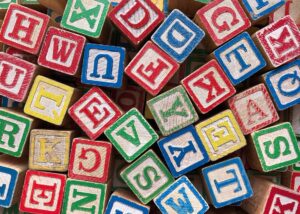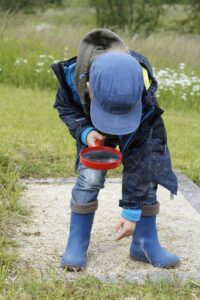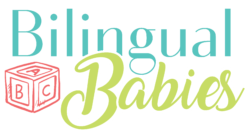Have your summer vacations started yet? Are you going on a long road trip or are flying somewhere and need to keep your children engaged? Here are some ideas for games that we have played in our family during long car rides, on planes, or simply when taking a walk. All of these games are not only time-passing activities, but they also allow you to use your family language(s) in a fun way while practicing certain aspects of language.
The guessing game
 This game builds on the classic Guess who?. It can be played with two or more players. One player secretly chooses a mystery character without telling the other players. The other players then have to ask yes-no questions in order to try to figure out the player’s mystery character. When they think they know who their opponent’s mystery character is, players make a guess. For example, Player A secretly selects a ‘mouse’. The other players then take turns asking questions like “Is it big?” or “Does it live in the water?” etc. A player can keep asking questions until the answer is “no”. Then, the next player gets to ask questions. The player who guesses the answer is the next person to choose a mystery character. You can play this game with any type of mystery character such as animals, movie stars, superheroes etc.
This game builds on the classic Guess who?. It can be played with two or more players. One player secretly chooses a mystery character without telling the other players. The other players then have to ask yes-no questions in order to try to figure out the player’s mystery character. When they think they know who their opponent’s mystery character is, players make a guess. For example, Player A secretly selects a ‘mouse’. The other players then take turns asking questions like “Is it big?” or “Does it live in the water?” etc. A player can keep asking questions until the answer is “no”. Then, the next player gets to ask questions. The player who guesses the answer is the next person to choose a mystery character. You can play this game with any type of mystery character such as animals, movie stars, superheroes etc.
Language focus: You can practice yes/no question formation, short term memory, and certain semantic fields (e.g., animals, movie stars, superheroes etc.).
I spy with my little eye…
 This game classic is often played with young children. It involves one person selecting an object within their field of vision and providing a clue to the other players, who then attempt to guess the object based on that clue.
This game classic is often played with young children. It involves one person selecting an object within their field of vision and providing a clue to the other players, who then attempt to guess the object based on that clue.
Here’s how the “I spy” game typically works:
Selection of the Spy: One person is designated as the “spy” and has the responsibility of choosing an object within their surroundings.
Clue Giving: The spy announces, “I spy with my little eye something that is [insert a color or shape].” For older children you can also include a focus on spelling: “I spy with my little eye something that begins with [insert the first letter of the object’s name].” For example, if the object is a rose, the clue might be “I spy with my little eye something that is red or round” or “I spy with my little eye something that begins with ‘R’.”
Guessing: The other players then take turns guessing the object based on the clue provided. They might say, “Is it a rose?” or “Could it be a rainbow?” The spy responds with “yes” or “no” until the object is correctly identified or someone gives up.
Rotation: Once the object is correctly guessed, the player who guessed it correctly becomes the new spy, and the game continues with a new object.
Language focus: In addition to encouraging observation and critical thinking, the game promotes the development of vocabulary and literacy skills, particularly as players need to describe objects using the adjective or initial letter clue.
If you were, what would you be?
 The “If you were, what would you be?” game is a creative and imaginative activity that allows players to engage in conversations. It involves participants envisioning themselves as an object, animal, or concept and describing what they would be and why.
The “If you were, what would you be?” game is a creative and imaginative activity that allows players to engage in conversations. It involves participants envisioning themselves as an object, animal, or concept and describing what they would be and why.
Here’s how the “If you were, what would you be?” game typically works:
Introduction: The game begins with someone posing the question, “If you were, what would you be?” or a variation of it, to the group or an individual.
Object, Animal, or Concept Selection: Each participant takes a turn to choose what they would like to be. It can be anything from an everyday object (e.g., a pencil, a chair) to an animal (e.g., a lion, a dolphin) or even an abstract concept (e.g., a rainbow, laughter).
Description and Explanation: The chosen participant then describes what they would be and provides a reason behind their choice. They might mention the characteristics, qualities, or symbolism associated with their chosen object, animal, or concept and explain how it relates to them.
Discussion and Reflection: After each participant shares their choice, the group can engage in a conversation, asking follow-up questions, discussing similarities or differences, and exploring the connections between the choices and the individuals’ personalities or aspirations.
The game encourages self-reflection, imagination, and sharing personal insights. It can be a lighthearted and enjoyable activity that fosters bonding, encourages self-discovery, and promotes deeper conversations among participants. It’s worth noting that there can be variations of this game, such as focusing on a specific theme or category (e.g., “If you were a superhero, what would you be?”) to add more structure or make it more tailored to particular interests or semantic fields.
Language focus: Interaction skills, specific semantic fields.
The alphabet game
 This game trains your short term memory and has your entire family come up with a story that can be fun, quirky, serious, or silly. The story always starts with “Last year, I went to [insert a location] and I took an [something that starts with an A]. Players take turns. The first player starts by saying something they take with them that starts with the letter ‘A’ (e.g., an apple). The second player has to repeat what the first player said and then add his object which needs to start with a ‘B’. Then, the third player adds an object that starts with a ‘C’. The following dialogue shows how this game can unfold:
This game trains your short term memory and has your entire family come up with a story that can be fun, quirky, serious, or silly. The story always starts with “Last year, I went to [insert a location] and I took an [something that starts with an A]. Players take turns. The first player starts by saying something they take with them that starts with the letter ‘A’ (e.g., an apple). The second player has to repeat what the first player said and then add his object which needs to start with a ‘B’. Then, the third player adds an object that starts with a ‘C’. The following dialogue shows how this game can unfold:
Player 1: Last year, I went to Germany and I took an apple.
Player 2: Last year, I went to Germany and I took an apple and a brush.
Player 3: Last year, I went to Germany and I took an apple, a brush, and a carrot cake.
You can also add some information around the objects to create a silly, fun, serious or scary story:
Player 1: Last year, I went to Germany and I took an apple that had a worm in it.
Player 2: Last year, I went to Germany and I took an apple that had a worm in it. And that worm took a brush and combed its hair.
Player 3: Last year, I went to Germany and I took an apple that had a worm in it. And that worm took a brush and combed its hair before eating a carrot cake.
For older children, you can choose any category for the words, such as animals, foods, or cities, to make the game more challenging and interesting. For example, if the chosen category is “animals,” the players might say “antelope” for the letter “A,” “butterfly” for “B,” and so on.
Language focus: You can practice the alphabet, short term memory, creativity, and certain semantic fields (e.g., animals, foods, clothes etc.)
The alphabet sign game
 Keep an eye out for road signs! This game is especially suited for long car rides. Players take turns having to spot words outside the car. These words can be on road signs, billboards, store fronts etc. For example, Player 1 needs to find a word that starts with the letter ‘A’. Then, the next Player needs to find a word that starts with a ‘B’, Player 3 has to find a word that starts with the letter ‘C’ and so on. You can also play it as a whole team. The goal: try to make it through the whole alphabet. Some letters are clearly more difficult to find than others!
Keep an eye out for road signs! This game is especially suited for long car rides. Players take turns having to spot words outside the car. These words can be on road signs, billboards, store fronts etc. For example, Player 1 needs to find a word that starts with the letter ‘A’. Then, the next Player needs to find a word that starts with a ‘B’, Player 3 has to find a word that starts with the letter ‘C’ and so on. You can also play it as a whole team. The goal: try to make it through the whole alphabet. Some letters are clearly more difficult to find than others!
Language focus: It helps your children pay attention to the written words around them.
Scavenger hunt
 Scavenger hunt is a game that adds an element of adventure and exploration to a journey. It involves searching for specific items or completing tasks while traveling. The goal is to find or accomplish as many items or tasks as possible within a designated time frame (e.g., during a walk or during a whole vacation) or distance (e.g., During a drive from Town A to Town B).
Scavenger hunt is a game that adds an element of adventure and exploration to a journey. It involves searching for specific items or completing tasks while traveling. The goal is to find or accomplish as many items or tasks as possible within a designated time frame (e.g., during a walk or during a whole vacation) or distance (e.g., During a drive from Town A to Town B).
Here’s how a scavenger hunt typically works:
Preparation: Before the road trip, create a list of items or tasks that can be reasonably found or completed on the trip. You can customize the list based on the interests of the participants or the places you’ll be visiting.
Scoring and Rules: Assign points or a value to each item or task on the list. Determine the rules, such as whether items must be collected or if a photo is sufficient as proof. You can also set a time limit or establish specific checkpoints where participants can gather and compare their progress.
Distribution of Lists: Provide each participant or team with a copy of the scavenger hunt list. It’s a good idea to have extra copies available in case someone loses theirs.
Scavenger Hunt: As the trip progresses, participants keep an eye out for the items or tasks on the list. They can mark off the ones they find or complete and keep track of their points.
Collaboration or Competition: Participants can either work individually or form teams to complete the scavenger hunt. Collaboration can make the experience more enjoyable, but competition can add an extra level of excitement. It depends on the preferences of the participants.
Scoring and Awarding: At the end of the road trip or at predetermined checkpoints, participants tally their points. The participant or team with the highest score is declared the winner and can receive a small prize or recognition.
The road trip scavenger hunt adds an interactive and engaging element to long drives, making the journey more entertaining and memorable.
Language focus: In addition to encouraging observation, teamwork, and creativity, the game also allows you to have your children focus on certain semantic fields (e.g., for younger children—clothes items, colors, animals/ for older children: cars, plants, cultural sights, landmarks etc.).

